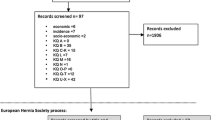Abstract
Introduction
Traumatic flank hernias (TFH) are caused by a blunt abdominal trauma with resultant detachment of the oblique musculofascial complex at the iliac crest and/or costal margin. Given such proximity to the bony structures and essential absence of healthy fascia to anchor the mesh, TFH represent a challenging surgical problem. Although laparoscopic repair of ventral hernias has become very common, no series of laparoscopic repairs of TFH has been reported to date. We present a series of patients undergoing laparoscopic repair of TFH.
Methods
After retrospective review of prospective hernia database at two Hernia centers, patients undergoing laparoscopic TFH repair were identified and analyzed. Main outcome measures included patient demographics, surgical technique, intraoperative data, and post-operative outcomes.
Results
From December 2007 to December 2013, 14 patients underwent laparoscopic repair of a TFH. Eleven patients had chronically incarcerated viscera within the defect. Operative steps included complete reduction of the hernia sac, pre/retroperitoneal dissection to expose the entire lateral edge of a psoas muscle, defect closure with transabdominal sutures, wide mesh overlap, and transabdominal suture fixation with selective use of bone anchors. The mean operative time was 174 min (range 125–230). Mean estimated blood loss was 65 cc. Mean mesh size was 295 cm2. There were no peri-operative complications. Mean hospital stay was 3.1 days and all patients returned to full activities by 6 weeks. At a mean follow-up of 35 months, there have been no recurrences.
Conclusion
Laparoscopic approach to TFH is feasible and safe. It is associated with minimal hospital stay and fast functional recovery. The key components of our approach include wide pre/retroperitoneal with defect closure and subsequent wide mesh underlay coverage with fixation to bony structures using anchors/screws. We believe that the laparoscopic approach should safely considered for the majority of patients with TFH.







Similar content being viewed by others
References
Gray SH, Hawn MT, Itani KM (2008) Surgical progress in inguinal and ventral incisional hernia repair. Surg Clin N Am 88:17–26 (vii)
Rutkow IM (2003) Demographic and socioeconomic aspects of hernia repair in the United States in 2003. Surg Clin N Am 83:1045–1051 v–vi
Kingsnorth A, LeBlanc K (2003) Hernias: inguinal and incisional. Lancet 362:1561–1571
Esposito TJ, Fedorak I (1994) Traumatic lumbar hernia: case report and literature review. J Trauma 37:123–126
Burt BM, Afifi HY, Wantz GE, Barie PS (2004) Traumatic lumbar hernia: report of cases and comprehensive review of the literature. J Trauma 57:1361–1370
Moreno-Egea A, Baena EG, Calle MC, Martinez JA, Albasini JL (2007) Controversies in the current management of lumbar hernias. Arch Surg 142:82–88
Stamatiou D, Skandalakis JE, Skandalakis LJ, Mirilas P (2009) Lumbar hernia: surgical anatomy, embryology, and technique of repair. Am Surg 75:202–207
Orenstein SB, Dumeer JL, Monteagudo J, Poi MJ, Novitsky YW (2011) Outcomes of laparoscopic ventral hernia repair with routine defect closure using “shoelacing” technique. Surg Endosc 25(5):1452–1457
Carbonell AM, Kercher KW, Sigmon L, Matthews BD, Sing RF, Kneisl JS, Heniford BT (2005) A novel technique of lumbar hernia repair using bone anchor fixation. Hernia 9:22–25
Payne DD, Resnicoff SA, States JD, Williams JS (1973) Seat belt abdominal wall muscular avulsion. J Trauma 13:262–267
Arca MJ, Heniford BT, Pokorny R, Wilson MA, Mayes J, Gagner M (1998) Laparoscopic repair of lumbar hernias. J Am Coll Surg 187:147–152
Sutherland RS, Gerow RR (1995) Hernia after dorsal incision into lumbar region: a case report and review of pathogenesis and treatment. J Urol 153:382–384
Bolkier M, Moskovitz B, Ginesin Y, Levin DR (1991) An operation for incisional lumbar hernia. Eur Urol 20:52–53
Lichtenstein IL, Shulman AG, Amid PK, Montllor MM (1989) The tension-free hernioplasty. Am J Surg 157:188–193
Nilsson E, Haapaniemi S, Gruber G, Sandblom G (1998) Methods of repair and risk for reoperation in Swedish hernia surgery from 1992 to 1996. Br J Surg 85:1686–1691
Vidovic D, Jurisic D, Franjic BD, Glavan E, Ledinsky M, Bekavac-Beslin M (2006) Factors affecting recurrence after incisional hernia repair. Hernia 10:322–325
Burick AJ, Parascandola SA (1996) Laparoscopic repair of a traumatic lumbar hernia: a case report. J Laparoendosc Surg 6:259–262
Edwards C, Geiger T, Bartow K, Ramaswamy A, Fearing N, Thaler K, Ramshaw B (2009) Laparoscopic transperitoneal repair of flank hernias: a retrospective review of 27 patients. Surg Endosc 23(12):2692–2696
Bickel A, Haj M, Eitan A (1997) Laparoscopic management of lumbar hernia. Surg Endosc 11:1129–1130
Heniford BT, Iannitti DA, Gagner M (1997) Laparoscopic inferior and superior lumbar hernia repair. Arch Surg 132:1141–1144
Woodward AM, Flint LM, Ferrara JJ (1999) Laparoscopic retroperitoneal repair of recurrent postoperative lumbar hernia. J Laparoendosc Adv Surg Tech A 9:181–186
Shekarriz B, Graziottin TM, Gholami S, Lu HF, Yamada H, Duh QY, Stoller ML (2001) Transperitoneal preperitoneal laparoscopic lumbar incisional herniorrhaphy. J Urol 166:1267–1269
Meinke AK (2003) Totally extraperitoneal laparoendoscopic repair of lumbar hernia. Surg Endosc 17:734–737
Madan AK, Ternovits CA, Speck KE, Pritchard FE, Tichansky DS (2006) Laparoscopic lumbar hernia repair. Am Surg 72:318–321
Iannitti DA, Biffl WL (2007) Laparoscopic repair of traumatic lumbar hernia. Hernia 11:537–540
Links DJ, Berney CR (2011) Traumatic lumbar hernia repair: a laparoscopic technique for mesh fixation with an iliac crest suture anchor. Hernia 15(6):691–693
Bathla L, Davies E, Fitzgibbons RJ Jr, Cemaj S (2011) Timing of traumatic lumbar hernia repair: is delayed repair safe? Report of two cases and review of the literature. Hernia 15(2):205–209
Author information
Authors and Affiliations
Corresponding author
Ethics declarations
Conflict of interest
This study was not funded. YWN has received research and educational grants from CR Bard and consulting fees from CR Bard, Cooper Surgical, and Intuitive Surgical outside the submitted work.
Ethical Approval
For this retrospective review, ethical approval is not required.
Human and animal rights
The article does not contain any animal studies.
Informed consent
For this retrospective review, formal consent is not required.
Rights and permissions
About this article
Cite this article
Novitsky, Y.W. Laparoscopic repair of traumatic flank hernias. Hernia 22, 363–369 (2018). https://doi.org/10.1007/s10029-017-1707-7
Received:
Accepted:
Published:
Issue Date:
DOI: https://doi.org/10.1007/s10029-017-1707-7




